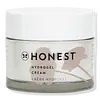What's inside
What's inside
 Key Ingredients
Key Ingredients

 Benefits
Benefits

 Concerns
Concerns

No concerns
 Ingredients Side-by-side
Ingredients Side-by-side

Water
Skin ConditioningPropanediol
SolventCaprylic/Capric Triglyceride
MaskingNiacinamide
SmoothingPanthenol
Skin ConditioningGlycerin
HumectantMacadamia Integrifolia Seed Oil
Skin Conditioning1,2-Hexanediol
Skin ConditioningCetearyl Alcohol
EmollientCetearyl Olivate
Glyceryl Stearate
EmollientSorbitan Olivate
EmulsifyingButyrospermum Parkii Butter
Skin ConditioningCitrus Aurantium Dulcis Peel Oil
MaskingSodium PCA
HumectantCarbomer
Emulsion StabilisingTromethamine
BufferingTocopherol
AntioxidantLimonene
PerfumingWater, Propanediol, Caprylic/Capric Triglyceride, Niacinamide, Panthenol, Glycerin, Macadamia Integrifolia Seed Oil, 1,2-Hexanediol, Cetearyl Alcohol, Cetearyl Olivate, Glyceryl Stearate, Sorbitan Olivate, Butyrospermum Parkii Butter, Citrus Aurantium Dulcis Peel Oil, Sodium PCA, Carbomer, Tromethamine, Tocopherol, Limonene
Water
Skin ConditioningSqualane
EmollientGlycerin
HumectantPolyglyceryl-4 Isostearate
EmulsifyingPyrus Malus Fruit Extract
Skin ConditioningCoco-Caprylate/Caprate
EmollientPropanediol
SolventDisteardimonium Hectorite
StabilisingJojoba Esters
EmollientSodium PCA
HumectantTocopherol
AntioxidantSodium Acetylated Hyaluronate
HumectantHydrolyzed Sodium Hyaluronate
Skin ConditioningTrisodium Ethylenediamine Disuccinate
Ceramide AP
Skin Conditioning1,2-Hexanediol
Skin ConditioningCaprylhydroxamic Acid
Water, Squalane, Glycerin, Polyglyceryl-4 Isostearate, Pyrus Malus Fruit Extract, Coco-Caprylate/Caprate, Propanediol, Disteardimonium Hectorite, Jojoba Esters, Sodium PCA, Tocopherol, Sodium Acetylated Hyaluronate, Hydrolyzed Sodium Hyaluronate, Trisodium Ethylenediamine Disuccinate, Ceramide AP, 1,2-Hexanediol, Caprylhydroxamic Acid
 Reviews
Reviews

Ingredients Explained
These ingredients are found in both products.
Ingredients higher up in an ingredient list are typically present in a larger amount.
1,2-Hexanediol is a synthetic liquid and another multi-functional powerhouse.
It is a:
- Humectant, drawing moisture into the skin
- Emollient, helping to soften skin
- Solvent, dispersing and stabilizing formulas
- Preservative booster, enhancing the antimicrobial activity of other preservatives
Glycerin is already naturally found in your skin. It helps moisturize and protect your skin.
A study from 2016 found glycerin to be more effective as a humectant than AHAs and hyaluronic acid.
As a humectant, it helps the skin stay hydrated by pulling moisture to your skin. The low molecular weight of glycerin allows it to pull moisture into the deeper layers of your skin.
Hydrated skin improves your skin barrier; Your skin barrier helps protect against irritants and bacteria.
Glycerin has also been found to have antimicrobial and antiviral properties. Due to these properties, glycerin is often used in wound and burn treatments.
In cosmetics, glycerin is usually derived from plants such as soybean or palm. However, it can also be sourced from animals, such as tallow or animal fat.
This ingredient is organic, colorless, odorless, and non-toxic.
Glycerin is the name for this ingredient in American English. British English uses Glycerol/Glycerine.
Learn more about GlycerinPropanediol is an all-star ingredient. It softens, hydrates, and smooths the skin.
It’s often used to:
Propanediol is not likely to cause sensitivity and considered safe to use. It is derived from corn or petroleum with a clear color and no scent.
Learn more about PropanediolSodium PCA is the sodium salt of pyroglutamic acid. It is naturally occurring in our skin's natural moisturizing factors where it works to maintain hydration.
The PCA stands for pyrrolidone carboxylic acid, a natural amino acid derivative.
This ingredient has skin conditioning, anti-inflammatory, and humectant properties. Humectants help hydrate your skin by drawing moisture from the air. This helps keep your skin moisturized.
Learn more about Sodium PCATocopherol (also known as Vitamin E) is a common antioxidant used to help protect the skin from free-radicals and strengthen the skin barrier. It's also fat soluble - this means our skin is great at absorbing it.
Vitamin E also helps keep your natural skin lipids healthy. Your lipid skin barrier naturally consists of lipids, ceramides, and fatty acids. Vitamin E offers extra protection for your skin’s lipid barrier, keeping your skin healthy and nourished.
Another benefit is a bit of UV protection. Vitamin E helps reduce the damage caused by UVB rays. (It should not replace your sunscreen). Combining it with Vitamin C can decrease sunburned cells and hyperpigmentation after UV exposure.
You might have noticed Vitamin E + C often paired together. This is because it is great at stabilizing Vitamin C. Using the two together helps increase the effectiveness of both ingredients.
There are often claims that Vitamin E can reduce/prevent scarring, but these claims haven't been confirmed by scientific research.
Learn more about TocopherolWater. It's the most common cosmetic ingredient of all. You'll usually see it at the top of ingredient lists, meaning that it makes up the largest part of the product.
So why is it so popular? Water most often acts as a solvent - this means that it helps dissolve other ingredients into the formulation.
You'll also recognize water as that liquid we all need to stay alive. If you see this, drink a glass of water. Stay hydrated!
Learn more about Water